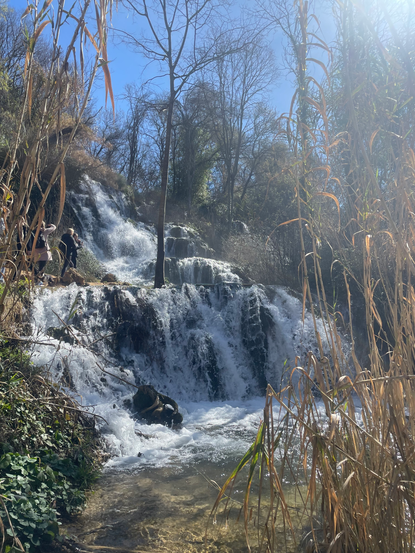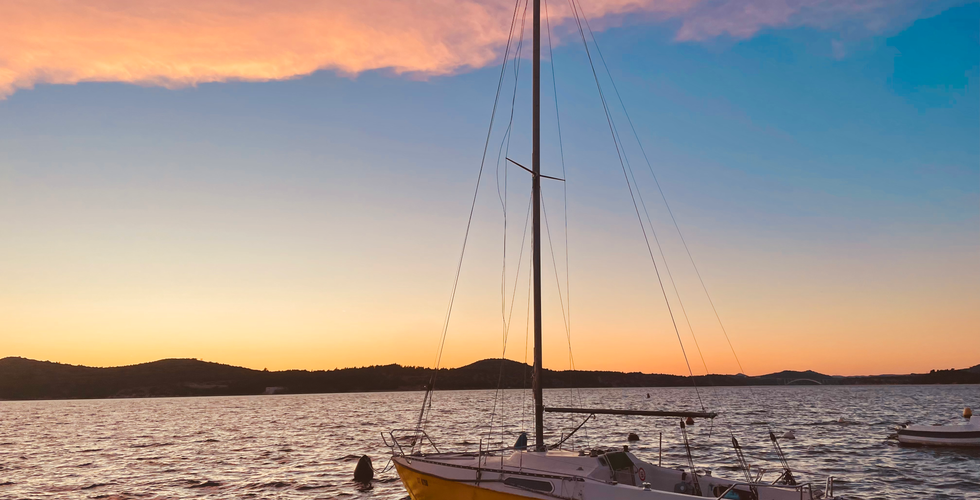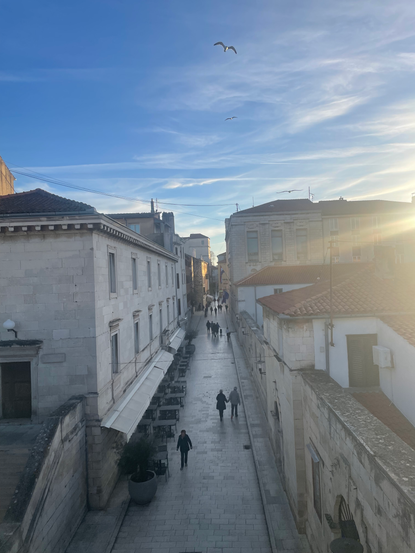This week was sandwiched between two of the most beautiful and unique waterfalls I've ever seen in my life.
First up was a visit to Krka National Park, one of the most popular destinations in Croatia and locaed just a short drive from the city of Split. Once we arrived to the park, our guide began to explain the many historic sites and cultural landmarks, including the Franciscan Monastery on the Island of Visovac (which we could not visit as it was off-season). We were able to walk around the several traditional water mills that have been restored and are still in operation today. Krka Waterfalls are formed by the Krka River, which flows through the park and drops over a series of rocky terraces. The rocky terraces have been formed over hundreds of thousands of years by the natural mineral deposits in the water, which have built up over plants, moss, and branches. As a result, the waterfalls are unique in that they are made up of numerous cascades and pools, which create a spectacular sight and a unique sound as the water flows over the rocks. Moreover, unlike some other waterfalls that can only be viewed from afar, Krka Waterfalls are accessible to visitors, who can walk along the wooden boardwalks and bridges that wind their way around the falls.
On the way back to Split, we stopped by the family-owned Sladić winery where we had the chance to try sorts indigenous to this area and a platter of homemade finger food to accompany it. The winery and wine-tasting experience was so special; they handpick their grapes and use only natural yeasts, allowing the wine to develop its unique flavor profile. They specialize in producing wines from indigenous grape varieties that are unique to area. As we were their first tasting of the season, we had the opportunity to taste many, many wine varieties and homemade Rakija (grappa). It was such a special experience that I'll never forget!
Our final stop was in a Sibenik, known for its beautiful architecture, rich cultural heritage, and stunning natural surroundings. The city is home to numerous historic sites, including the UNESCO-listed St. James Cathedral, which is widely considered to be one of the finest examples of Renaissance architecture in Croatia. The cathedral features intricate stone carvings and a unique frieze depicting 71 human heads, which has become an iconic symbol of Šibenik. We watched the sunset from a local caffe, enjoying yet another glass of wine before headed back to Split.
The rest of the week was a heavy work week for me, but I was able to split up computer time by climbing up and down Marjan Hill several times. Marjan Hill is a picturesque hill located on the western side of the city of Split in Croatia. The hill is a popular destination for locals and tourists alike, offering stunning views of the city and the Adriatic Sea. It is covered in dense pine forests and dotted with scenic walking paths and hiking trails. At the top of the hill, visitors can find the 15th-century St. Nicholas Church, which offers another vantage point for enjoying the breathtaking views. I found it to be a great place to escape the hustle and bustle of the city and experience the natural beauty of the Dalmatian coast.
Friday was a special day for many reasons, but mostly because Alex and I achieved local status. We had been going to our local cafe, Miss Caffe, several times since moving into our accommodations. When we went for coffee on Friday, we waited a bit longer than expected to be asked about our order. Instead, the bartender came out WITH our typical order - two coffees with hot milk (the traditional Croatian way). I was absolutely floored and may have almost cried.
The following day, I woke up early for a day trip to visit the famous Plitvice lakes, best known for their exceptional beauty recognized by UNESCO since 1979. This national park is one of the most spectacularly attractive areas on Earth, with incredibly crystal clear water flowing over a variety of waterfalls, cascades and lakes in a vast lush green environment loved by millions that come to visit every year. The drive from Split to the park took approximately 3 hours. Once there, we took a relaxing and enjoyable hike along a wooden plank trail that weaves between waterfalls and lakes. Similar to Krka, these waterfalls were created because of the mineral deposits in the water.
Walking around Plitvice Lakes National Park was a truly unforgettable experience. The park is home to a series of interconnected lakes and waterfalls, set against a backdrop of lush forest and soaring mountains. I was treated to stunning views at every turn, with the crystal-clear waters of the lakes reflecting the surrounding scenery in a dazzling display of colors. The park's wooden planked trails were a unique feature; the wooden planks carefully fitted together to create a durable and sustainable path through the park. We ended our lakeside time by visiting the tallest waterfall in Croatia, Veliki Slap, which stands an impressive 256 feet tall. I had the chance to get up close to the waterfall (and got soaked in the process!). We began our ascent to return to the trailhead and had the special experience to see the lakes from the top. There were breathtaking views of the park and the surrounding countryside.
Before heading back to Split, we stopped for lunch before our stop in Zadar, known for its rich cultural heritage, stunning architecture, and beautiful beaches. Zadar is home to numerous ancient Roman ruins, including the Roman Forum and the ruins of the ancient city walls. The city is also home to the famous Sea Organ, an art installation that uses the natural sounds of the sea to create a unique musical experience. Hearing the Sea Organ for the first time is a truly unique experience that is hard to put into words. As you approach the installation, you hear a faint sound that gradually grows louder and more distinct. The notes are soothing and peaceful, like a gentle lullaby that echoes through the air. The sound is created by the movement of the waves, as they flow through a series of pipes that are embedded beneath a set of concrete steps leading down to the sea. The Sea Organ is essentially an instrument that is played by the sea itself, with each wave producing a different note. The installation was created by architect Nikola Bašić, who designed the pipes to produce a range of harmonious sounds that reflect the natural rhythm of the sea. The result is a hauntingly beautiful melody that is both soothing and captivating, providing a unique sensory experience that is unlike anything else in the world.


























































Comments